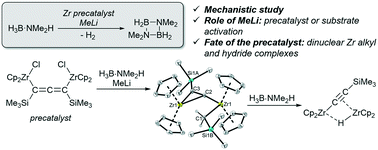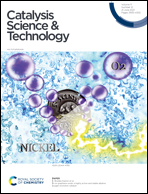Mechanistic insights into dehydrocoupling of amine boranes using dinuclear zirconocene complexes†
Abstract
Catalytic dehydrocoupling of H3B·NMe2H using the in situ system Cp2Zr(Cl)(μ-Me3SiC3SiMe3)Zr(Cl)Cp2 (1)/MeLi was studied as a model for previously reported dehydropolymerisation of H3B·NMeH2. NMR and UV-vis spectroscopic monitoring of the precatalyst activation sequence as well as a series of stoichiometric experiments showed that formation of a zirconocene dimethyl complex (2) is not relevant for activation of the precatalyst. Instead, deprotonation of H3B·NMe2H and reaction of thus formed Li[NMe2BH3] is proposed to result in the formation of Zr amidoborane and hydride species. DFT analysis using such complexes as active species showed a pathway for formation of H2 and H2B![[double bond, length as m-dash]](https://www.rsc.org/images/entities/char_e001.gif) NMe2. 1H NMR spectroscopic monitoring and stoichiometric control experiments revealed the formation of unusual diamagnetic dinuclear complexes Cp2Zr(C2SiMe3)(μ-R)ZrCp2 (R = CH2SiMe3, 7; R = H, 9) formed by activation of the allenediide unit of the precatalyst 1. Such species can be regarded as rare single-component catalysts for the dehydrocoupling of amine boranes.
NMe2. 1H NMR spectroscopic monitoring and stoichiometric control experiments revealed the formation of unusual diamagnetic dinuclear complexes Cp2Zr(C2SiMe3)(μ-R)ZrCp2 (R = CH2SiMe3, 7; R = H, 9) formed by activation of the allenediide unit of the precatalyst 1. Such species can be regarded as rare single-component catalysts for the dehydrocoupling of amine boranes.



 Please wait while we load your content...
Please wait while we load your content...